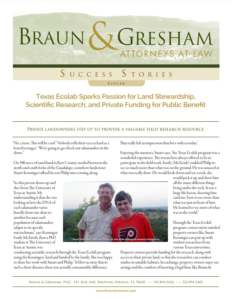Private Landowners Step Up To Provide a Valuable Field Research Resource
“No, c’mon. This will be cool.” Nobody rolls their eyes as hard as a bored teenager. “We’re going to go check out salamanders in the draws.”
On 500 acres of ranchland in Kerr County, nestled between the north and south forks of the Guadalupe, somehow landowner Stuart Kensinger talked his son Philip into coming along.
“So this person shows up and she’s from The University of Texas at Austin. My understanding is that she was looking at how the DNA of each salamander varies literally from one draw to another because each population of salamanders adapts to its specific microclimate,” says Kensinger. Emily McTavish, then a PhD student at The University of Texas at Austin, was conducting scientific research through the Texas Ecolab program using the Kensingers’ land and funded by the family. She was happy to share her work with Stuart and Philip. “It blew us away that in such a short distance there was actually a measurable difference. That really left an impression that lives with us today.”
Enjoying the memory, Stuart says, “the Texas Ecolab program was a wonderful experience. The researchers always offered to let us participate in the field work. Emily (McTavish) enabled Philip to see so much more than what was on the ground. He was amazed at what was really there. He would look down and see a rock, she would pick it up and show him all the many different things living under the rock. It was a huge life lesson, showing him (and me) how to see more than what was just in front of him. He learned to see more of what was in the world.”
Through the Texas Ecolab program, conservation-minded property owners like Stuart Kensinger can pair up with student researchers from various Texas universities. Property owners provide funding for the research, along with access to their private land, so that the researcher can conduct studies in suitable habitats. In exchange, property owners enjoy tax savings and the comfort of knowing a legal firm, like Braun & Gresham, will coordinate, negotiate the program terms and address any liability issues affiliated with land ownership.
Typically, properties must be grazed or farmed for a minimum of five years to qualify for Agricultural (Ag) tax rates. Texas Ecolab offers a cost-effective alternative to landowners not currently in traditional Ag. Under the program, instead of grazing land or farming, the owner allows universities the opportunity to study on their land for two years, after which they can convert to another type of Ag valuation, called Wildlife Management, if desired. It’s an important opportunity for landowners who do not have land suitable for ranching, or lack the time and ability to run a farm or ranch. But for Stuart Kensinger, it’s much more than that. “It was less of a tax issue and more of a stewardship issue,” he says. “I wanted to be more responsible with the land.”
“Texas Ecolab has become a part of what we do,” says Stuart, “and the more you do, the bigger impact you can have.”
This particular piece of land has been in Stuart’s family since he was in high school. They started with 100 acres, part of a larger 2,300 acre development of what he calls “ranchettes.” Over the last 30 years, the Kensingers have been acquiring land just outside the development in 100-acre increments. This land means a lot to Stuart as well as the now college-aged Philip. “It became a big part of his life — I would even say his identity.”
Attorney Cassie Gresham with land advocate law firm Braun & Gresham initially presented Texas Ecolab to Stuart as a way to help the family convert their land to wildlife management valuation. The program was a great fit for the Kensingers for the tax benefits as well as the chance to improve their stewardship of the land. For the family, discovering how much they enjoyed learning about the research and working alongside the scientists was an unexpected bonus.
“Another great benefit to Texas Ecolab was that we began to understand our land better,” says Kensinger. “My son and I also began to appreciate and experience the land in a different way.” Over the years, Stuart and his family have been working to clear and restore their land, after learning of the damage done by overgrazing decades ago. One of the Texas Ecolab research projects on the Kensinger land involved native grasses, which actually helped inform Stuart’s efforts. “As we corrected conditions, five or six of the native grasses that had almost disappeared came back. Now we’re seeing an amazing comeback of bobwhite quail and our turkeys. We’re seeing this whole chain reaction of healthy responses to relatively modest efforts. I couldn’t have done this without Texas Ecolab.”
Stuart says, “It was surprising to me how inexpensive it was for the kind of impact we could create. I don’t remember spending more than a couple thousand dollars on a Texas Ecolab project and some were less than a thousand. We got a lot of personal satisfaction out of allowing these grad students or post-docs come on the land and share in that experience. I think that’s a great deal.” Stuart is so passionate about Texas Ecolab that he’s convinced several of his friends and neighbors at Comanche Caves Ranch to get involved too. In total, the Kensinger family has funded eight years of Texas Ecolab research — well beyond the original two-year program.
The initial property tax savings from Texas Ecolab gives landowners the incentive to get started. The legal protection and program
orchestration from attorneys like Braun & Gresham gives them peace of mind and a hassle-free experience. The entire Texas Ecolab program gives landowners opportunities to learn more about effective stewardship and enable important agricultural and wildlife research. And that’s great for Texas.



